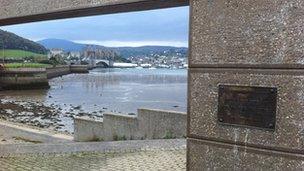Conwy Tunnel praised on 20th anniversary
- Published
It is 20 years since the Queen opened one of the most important feats of civil engineering in Wales.
The tunnel carrying the main A55 road underneath the River Conwy was the first of its kind in the UK.
But it also brought an end to years of traffic jams in Conwy and and created a new nature reserve and marina.
Many people in Conwy remember the horrendous traffic jams that built up in the castle town in the years before 1991.
Ieuan Edwards, who runs a butcher's shop and delicatessen in the High Street, and has been in business for nearly 30 years, said: "In August, you had to hope and pray that you didn't have to go over the bridge.
"If you did, the traffic was often so bad it used to take us three to four hours to do a round trip of five miles.
Difficult choices
"During the summer months, every single wagon, bus and car that was heading to Ireland on the ferry had to come through Conwy town centre - and they did."
The A55, the main road across north Wales, used to cross the river on a bridge and run through the middle of Conwy.
The original bridge, built by Thomas Telford and opened in 1826, had already proved too small for the traffic and been replaced in 1958.
Bypassing Conwy gave civil engineers and planners some difficult choices.
In the end, they opted to build a tunnel rather than a third road bridge.
Biggest contract
One those making speeches at the opening day in October 1991 remarked: "It is the castle together with its setting in the beautiful and irreplaceable environment of the Conwy estuary which are the reasons why we are gathered here to celebrate the opening of a tunnel, rather than a bridge."
.jpg)
The tunnel was officially opened in October 1991
Bob Daimond, an independent civil engineering consultant, who was deputy county surveyor of the then Gwynedd county council, said the tunnel was "quite an achievement".
"It took five years to build, and was the biggest road contract ever in the UK at the time," he explained.
"It was also the first immersed tube tunnel in the UK.
"The technique had been used in Hong Kong and the low countries before, but never in Britain.
"Basically, instead of digging through the bed of the river, you take the river away, dig a trench, drop pre-cast concrete units in place, then put the sand and gravel back to recreate the river bed."
Nature reserve
But the tunnel did not just relieve traffic congestion. Mud, sand and silt taken from the bottom of the river was used to create a new nature reserve at Llandudno Junction.
Julian Hughes, who works for the RSPB, has a close connection with the tunnel because 20 years ago he worked as a marshal when people were allowed to walk through it before the official opening.
He says the idea for a reserve came about almost by accident.
"The original plan was that they were just going to grass it over and maybe have sheep grazing on it and who knows what it would be today.
"But a couple of people at the local council, over a pint as I understand it, had this idea that they should do something better.
"So they got in touch with the RSPB and that gave us chance to design a nature reserve pretty much from scratch.
"The reserve was built from 3m tonnes of mud and sludge which had been at the bottom of the river for the last 10,000 years.

Traffic movements inside the tunnel are monitored from a control room
Cutting edge
"When they put the tunnel sections into place they couldn't pump it out towards the end of the estuary because of the mussel beds.
"So they banked off part of the estuary and used something like the worlds biggest vacuum cleaner to suck it over here."
Twenty years on, the tunnel is still at the cutting edge of technology.
Traffic movements are monitored from a control room and special cameras detect if any vehicles have stopped inside.
Mr Edwards said traders in Conwy were also happy with the tunnel.
"We were slightly concerned when it opened because we felt that much of the passing traffic was stopping here and spending time and money here," he said.
"But we needn't have worried. As soon as the tunnel opened the heavy haulage traffic was replaced by people coming here specially to visit and enjoying their time here more."
The RSPB is organising an exhibition of photographs and memorabilia from the opening day at the reserve in the next few weeks.
- Published2 September 2010